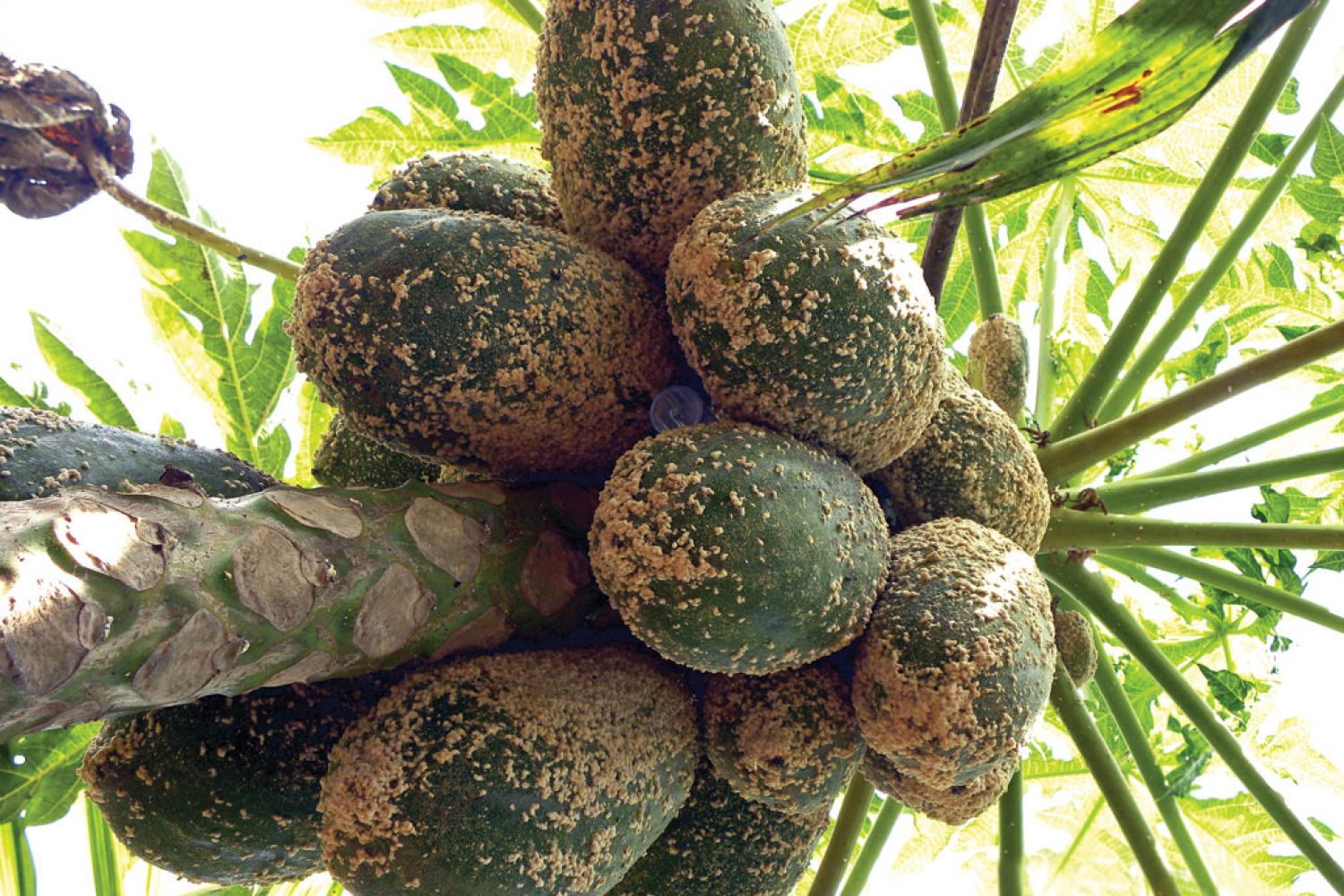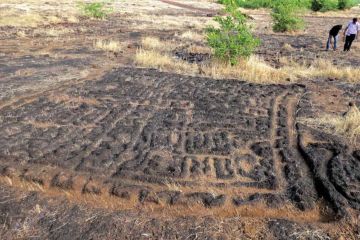
One morning in November 2010, Radha Doraisamy had a test tube in her hand and doubts on her mind. Three years earlier, she had given up on papaya farming after her grove of six acres was destroyed by a pest. The bug had overrun her farm in no time. In two months, the biennial crop of papaya fruits were shrouded in a white, fluffy cotton mass, making the harvest useless.
In her forties, Radha, whose two children work in Chennai, spends most of her day on the farm. In a region where absentee landlordism is much prevalent, Radha bucks the trend and lives in a two-storey house in the middle of her 20-acre farm.
Every day she wakes at five a.m. and does the rounds, often talking to the plants. She farms papaya, coconut, cassava and sugarcane, crops suited to the black cotton soil of the Deccan region.
Radha’s decision to stay put at her farm in a landlocked village—increasingly under threat by forces of urbanisation from Mettupalayam in the north and Coimbatore in the south—seemed to have paid off. Her crops sold well, till the papayas started turning white.
The destroyer of crops—a Mexican traveller that left a trail of destruction and economic gloom in its path—was a yellow insect smaller than the eye of a needle, called the papaya mealybug. Or Paracoccus marginatus, as the scientists identified it.
The test tube contained close to a hundred wasps that act as a parasite on the pest. The wasps would lay eggs inside the pest and, once hatched, the larvae would consume the internal organs of the host and kill it.
Within a year, the mealybug had spread all across south India, and papaya production had fallen by as much as 80 per cent. Indian farmers were losing an estimated ₹1,500 crore annually as the bug continued its flight of conquest. Radha suffered a loss of ₹30 lakh that year: she had spent ₹5 lakh on planting papaya, and ₹25 lakh as loss of income on account of the damaged fruit.
It was eight months before Radha could make a fresh start. This time, she was told, there was a solution at hand. A way had been found to get rid of the pest that had destroyed papaya crops in four states and was spreading northward.
The solution seemed absurdly simple. All Radha had to do was to take a test tube provided by the government, unseal it, and amble down the papaya grove, tilting it towards the black soil. The test tube contained close to a hundred wasps—so small that they were barely discernible—that act as a parasite on the pest. The wasps would lay eggs inside the pest and, once hatched, the larvae would consume the internal organs of the host and kill it.
Like Radha, more than 20,000 farmers across Tamil Nadu were provided with these tubes and asked to unseal them and walk around their farms.
Radha’s discomfort was understandable. The test tube and the power accorded to it were in stark contrast to traditional pest management techniques she was familiar with. Typically, once a pest attack occurs, the farmer buys a bottle of pesticide from the local agricultural store, dilutes it with water, loads it in a mechanical sprayer, and sprinkles the pesticide through a nozzle on to each and every plant in the field. Each spraying would cost close to ₹9,000 per acre. And this had to be repeated a few times until the harvest.
In contrast, the proposed solution was a one-time intervention. In fact, after the introduction of wasps, the mealybug incidence was controlled not only in fields where they were released, but also in neighbouring grounds. This is because subsequent generations of the wasp moved out in search of the mealybug.
Radha’s unsealed and tilted test tube contained the hope that farmers who had lost much to the bug sorely needed.
Masquerading behind the simplicity of the solution is the account of a technique that was formulated in the late 19th century, but which is much more in tune with modern sensibilities on environmental protection. Classical biological control, or biocontrol as it is known, predates the widespread use of pesticides, bypassing the ill-effects of chemicals.
Behind the success of such experiments as the papaya mealybug case is the little known effort of the Indian government that goes back to 1977, when it launched a nation-wide project connecting agricultural universities on alternate pest management techniques. Or that of the British government in 1957, which established an Indian station for the exploration of these solutions for pests in its homeland.
Biocontrol is based on the premise that every pest in the ecosystem has a “natural enemy”, like cats are to rats. The natural enemy keeps the pest population at a level that does not cause any economic damage.
When a pest outbreak occurs, it is inevitably because of the destruction or absence of the natural enemy. With trade liberalisation and greater movement of goods between nations, pests from one country often end up in other countries without the presence of their natural enemy. This leads to an explosion of the population of the pest.
Another reason for an outbreak is the destruction of a pest’s natural enemies. The predator population could decline as a result of broad-spectrum pesticides which kill a large range of insects, including useful ones. Classical biological control is about restoring this balance by introducing the pest’s natural enemy.
***
T
he first recorded instance of the papaya mealybug outbreak in India was by Dr Rangaswamy Muniappan—director of the Integrated Pest Management Collaborative Research Support Program, Virginia Tech University—when he was visiting papaya orchards around Coimbatore in July 2008. Mealybugs are common in India and are generally considered minor pests, but this one was different.
“He, in fact, came to us and told us to take a look at this bug. He said this was not native to India, and could cause considerable harm to the state,” says Dr M. Kalyanasundaram, a professor from the Department of Entomology, Tamil Nadu Agricultural University (TNAU), headquartered in Coimbatore.
Within two weeks, Muniappan’s warning came true. Every day, at least 20 farmers would arrive, carrying leaves and fruits enveloped in white. From a distance, it looked as if cotton stuffing from pillows had drifted in the air and entangled with the plants. Touch revealed the white coating to have a waxy texture.
What was happening at fields across the district was also taking place in the experimental farm within the university campus. Muniappan noticed that papayas grown on the campus were also showing similar signs of infestation.
He made a call to Dr R. J. Rabindra, then the director of the National Bureau of Agriculturally Important Insects (NBAII) based in Bangalore. He reported his observations and told him that he suspected the new pest could be the papaya mealybug. Soon, Rabindra and his colleague Dr A. N. Shylesha, principal scientist (agricultural entomology) at NBAII, were catching a flight to Coimbatore to conduct a survey. The two NBAII scientists surveyed nearly 20 different plants besides the papaya at the TNAU campus and found that the pest had attacked just two plants in the orchard. Another survey conducted at a field in Sathyamangalam yielded no result.
As per the standard operating procedure for transportation of unidentified exotic insects, the transportation of live specimens was not allowed. So the two NBAII scientists cut stamp-size samples of affected leaves and fruits and inserted them into a vial with 70 per cent alcohol. They flew back to their Bangalore lab.
W
hen Radha first noticed the pest in 2007, other farmers had already identified it as the kalli poochi. It was so named since the bug was initially found on the cactus-like Opuntia plant, locally known as the kalli plant. She found that that the bug was initially feeding on the leaves of the papaya plant, but soon moved onto the papaya fruit itself.
Papaya is an important fruit for India, with annual production being in the region of 6 million tonnes, almost half of the world production. Besides the southern states, papaya is also grown in Odisha, West Bengal, Gujarat, Assam, and Madhya Pradesh on about 80,000 hectares.
“When I saw my papaya crop, it was entirely covered with a white coat. You could not recognise it as a fruit. It looked like a white flower,” Radha says. Kalli poochi soon also began to be known as maavu poochi (white flour insect).
In the early morning, Radha would notice that the morning breeze was dispersing the cotton-like masses into neighbouring fields. When she entered the field, her entire body would be covered in white trails.
***
T
he kalli poochi or the papaya mealybug appears as a cluster of cotton-like masses on the surface of leaves and fruits. The adult female is a yellow elongated oval insect, about two millimetres (mm) long and 1.5 mm wide, and hides partially behind a white, waxy coating. Unlike other mealybugs found commonly in India, the unique thing about the papaya mealybug is that its body’s white coating allows it to withstand pesticides much better than most other pests.
India was involved in biocontrol in the 18th century when mynahs were transported to Mauritius to control locusts. It was a great success.
Once on a plant, it inserts its elongated pointed mouth into the skin of the leaf, fruit or stem, and feeds on the sap of the plant. The bug also injects a toxin into the leaves leading to deformation, stunting, and hampering the leaves’ ability to produce chlorophyll. Leaves and fruits begin dropping early, and the plant dies soon. On the fruit, heavy infestation leaves a thick white wax on the surface and make it unfit for human consumption.
The pest was officially identified in July 2008 and by December that year it had spread to the neighbouring districts of Erode, Tirupur, Salem and Namakkal. Initially, the outbreak was kept partially in check through a pest management programme put in place by the TNAU that emphasised monitoring, early detection, destruction of infested crops, and application of insecticides.
But by the summer of 2009, when conditions were ideal for breeding, the mealybug became aggressive and spread all over Tamil Nadu and to neighbouring states. Large-scale damage was reported on papaya plantations in most south Indian states, and the pest had also begun to attack cassava and mulberry.
***
I
n some ways, the origins of bio-control hark back to ancient times. Ants featured substantially in controlling pest outbreaks. In China, Pharaoh’s ants were used to control pests in stored grains, while red ants were used to control caterpillars feeding on foliage. Historical texts record that ant nests were sold near Canton in the 3rd century for control of citrus pests.
India was also involved in one form of biocontrol in the 18th century when mynahs were transported to Mauritius to control locusts. It was a great success. Modern classical biocontrol as we know it today was first introduced by Charles Valentine Riley in California. An Englishman who migrated to the United States when he was a teenager, Riley’s expertise in insects arose from his observations as a teen on a farm in Illinois, where he began to write on insects that were damaging crops for a local magazine.
By 21, he began writing, illustrating, and editing for an entomological magazine in Chicago. His work began to get noticed: his detailed illustrations and vivid descriptions combined with his perseverance in tracking down insects and the damage they caused crops got him his next job.
Eventually, through his friendship with the Illinois state entomologist, he landed the job of state entomologist at Missouri in 1868. Riley had very divergent views on insects and he went to great lengths to persuade people. He would famously treat visitors to a four-course meal comprised of locust soup, baked locusts, locusts and honey, and plain locusts.
But Riley’s status as the “Father of Biological Control” came about by his role in containing a pest outbreak in France’s vineyards, and later his role in California’s citrus orchards.
At the time, the cushion scale insect was devastating citrus groves and ornamental plantings throughout California. The growers suspected that the scale insect had arrived through a shipment of acacia from Australia, and petitioned the government to find a solution.
Riley sent two entomologists to Australia to investigate the cottony cushion scale and find natural predators or parasites of this insect. Research in Australia found that the vedalia beetle could be used successfully to bring down the population of the scale insect. The beetles were brought back to California and within months, farmers reported that the vedalia beetle was eradicating the cottony cushion scale.
More importantly, this was done at just $1,500, while the savings to growers were estimated to be in millions. Exports from Los Angeles County nearly tripled after the pest infestation was checked. To this day, vedalia beetles are used to control the pest in citrus orchards from the cottony cushion scale.
From Missouri, Riley went on to be appointed as the chief of the entomological service for the US Department of Agriculture (USDA). After donating his entire collection of insects, close to a 1,00,000 specimens to the US National Museum, he became the museum’s first curator of insects.
***
B
ack from the field survey at Coimbatore, the pest samples were provided to NBAII’s in-house expert on insect taxonomy Dr Sunil Joshi, principal scientist of the Division of Insect Systematics. He looked up literature on mealybugs across the world and, after matching the characteristics of the specimen, confirmed its identification as the papaya mealybug.
The literature also pointed out that the papaya mealybug had originated in Mexico and caused havoc in a few other countries. Biocontrol had already been attempted with some success in Guam, Palau islands, and most recently Sri Lanka.
“Though it’s difficult to exactly say how the mealybug entered India, most likely it would have come through Sri Lanka,” says Shylesha.
NBAII contacted the US Department of Agriculture (USDA), and it directed them to Sri Lanka to obtain the natural enemy of the bug.
“Though they agreed to give us the parasite, Sri Lanka was in the midst of a war at the time due to the LTTE conflict,” says Shylesha. By the time the war was over, they had stopped breeding the parasatoid as the pest had already been suppressed.
So the NBAII approached the USDA office again, and signed an MoU to obtain three parasatoids for free.
***
O
ne form of biocontrol involves the use of predators. “Predators are the lions or tigers of the insect world. They just catch the pest, chew them up, and devour them,” says Dr Prashant Mohanraj, principal scientist and head of the Division of Insect Systematics, NBAII.
The other form of biocontrol is through the use of parasatoids. Instead of feeding on a pest, parasatoids lay eggs within the pest and when the eggs hatch, the larvae feed on the internal organs of the host and emerge as adult insects. In some cases, eggs are laid within the eggs of the host pest, and the pest is not even allowed to hatch.
Parasatoids are the most commonly used natural enemies in biocontrol. Where these interventions don’t work, the biocontrol playbook also involves strategies such as spraying a fungal or viral pathogen. The pathogen infects the insects with a disease, and the pest dies naturally.
Once the natural enemies of a pest are identified, scientists have to find a method of multiplying them in large numbers in a laboratory. Only some are amenable for culturing in the lab, says Mohanraj. “What happens is that, to culture it in the lab, you have to have another host. It has to feed; since they’re all carnivorous, they need an insect,” he says.
Under Indian regulations, predators and parasatoids introduced from outside the country have to undergo a rigorous testing process. First, a specifity test is performed to ensure that the introduced insect is highly selective of its target and that it doesn’t attack other productive insects like honeybees or silkworms.
Acerophagus papayae is a yellow wasp with transparent wings and bluish eyes. Each female can lay 50 eggs in its lifetime of 35 days. With one egg per mealybug, a single wasp can effectively kill 50 mealybugs.
Inside the NBAII laboratory, the parasite was tested first in free choice and restricted choice conditions. In the free choice test, the parasite is tested against all possible insects that are available in the ecosystem. Shylesha says that it’s like a bride in a room full of potential bridegrooms—she can choose any one of the “bridegrooms” in the room. If there are 10 insects in the ecosystem, then the parasite is released in an environment where all 10 insects, including the pest are present. Each individual insect is tested for the presence of eggs from the parasite.
Next, the parasite is paired with each pest one at a time, creating a forced feeding environment. “If under forced feeding it is going to target the wrong insect, then we reject the parasite as a suitable candidate”, he says. The idea of a parasite that can adjust to other hosts is not preferred.
The parasatoid also has to undergo safety tests to ensure that it does not target existing natural enemies and productive insects in the ecosystem.
***
I
n July 2010, the USDA office sent five consignments of the three natural enemies of the papaya mealybug to NBAII by FedEx. Each consignment consisted of three vials of each parasatoid: about 200 each. Indian regulations impose extensive measures whenever a new species is being introduced into India to ensure that no harmful species are let loose in the Indian environment.
NBAII had to first obtain an import permit from the Plant Protection Advisor headquartered in Faridabad. The consignments, which arrived at Mumbai, were then inspected by quarantine officers. In case a permit is not granted, the quarantine officers are empowered to confiscate and destroy the consignment. From Mumbai, the packages were transported to NBAII, where they were unboxed at the quarantine building.
The vials containing the parasatoids had to be maintained at low temperatures to extend their life. The typical lifecycle of the pests is between five and seven days at 25°C to 35°C. Lower the temperature between 15°C and 25°C, and its metabolism slows down, and the lifecycle stretches by another five to seven days.
The parasatoids imported by NBAII were three species of wasps that were natural enemies of the mealybug. The specificity test found that two of three accepted none other than the papaya as a host, while the third one also accepted the cassava mealybug as a host.
The safety tests also yielded positive results: no productive insect in the agricultural ecosystem was targeted by the parasatoid.
Following this, the NBAII sent the report to the Plant Protection Advisor and received a release permit to go ahead with the field trials in early October 2010. With the help of the TNAU, field tests on all three parasatoids were conducted in Coimbatore by handing test tubes of the parasites to farmers. Pest incidence came down significantly and immediately in the trials. A national consultation of agricultural experts in Bangalore zeroed in on the Acerophagus papayae as the most suitable of the three for Indian conditions.
***
T
he Acerophagus papayae is a yellow wasp with transparent wings and bluish eyes. Each female can lay 50 eggs in its lifetime of 35 days. With one egg per mealybug, a single wasp can effectively kill 50 mealybugs, and the emerging 50 wasps can kill another 50 mealybugs each, resulting in an exponential rise in the population of wasps.
To get some sense of the wasp’s action on the mealybug, the TNAU has released a video taken with the aid of an electron microscope. In it, the wasp is frantically running along the plant body, searching for the presence of a mealybug to lay its egg. The wasp’s antennae are tuned to pick up the chemicals emitted from a mealybug infested plant.
Close to 5.7 million wasps were released in fields. The parasatoids were sealed in test tubes and handed over to farmers in Karnataka, Kerala, Andhra Pradesh, and Maharashtra too.
Once it identifies a mealybug, it looks for a suitable place to lay its egg within the mealybug. The wasp then inserts its ovipositor (a tubular organ through which a female insect or fish deposits eggs) in the host. If suitable, the wasp continues inserting it and injects the egg into the mealybug. If unsuitable, it looks for another insect.
Within a few minutes, the insertion is complete, and after it withdraws, the mealybug performs a reflexive motion, pushing its body upwards and back to normal position. The wasp, after cleaning itself of the waxy substance from the mealybug, proceeds to find its next host.
Once the eggs within the mealybug hatch, the immature wasps begin feeding on the internal organs of the host. Once the adult stage has been reached, the wasp emerges by cutting through the body of the mealybug, which is dead by now. The adult wasp now goes in search of other mealybugs to attack
***
T
he only way to breed the parasatoid is by breeding the target pest. However, since papaya takes a long time to grow in the lab, the NBAII decided to breed the target pest on potatoes in the laboratory.
Representatives from different parts of the country took the parasatoid and the culture materials, multiplied the parasatoid in large numbers, and provided them to farmers. “It was a carpet coverage of parasatoids across India. The population of pests started coming down significantly,” says Shylesha.
In Coimbatore, the TNAU began training on mass multiplication of the wasps, involving colleges, research stations and Krishi Vigyan Kendras across the state in the process. Within a year, close to 5.7 million wasps were multiplied by the university and released in fields. Due to high demand, initially each village was provided with around 100 wasps, but soon enough individual farmers were provided with the wasps. The parasatoids were sealed in test tubes with a black cloth and handed over to farmers. Similar exercises were conducted in Karnataka, Kerala, Andhra Pradesh, and Maharashtra too. The Karnataka and Kerala governments also proceeded to do the same.
In Silent Spring, the book that launched the environment movement in 1962, Rachel Carson explains the inability of chemical pesticides to distinguish between the good and the bad.
She writes, “These sprays, dusts, and aerosols are now applied almost universally to farms, gardens, forests, and homes—nonselective chemicals that have the power to kill every insect, the ‘good’ and the ‘bad’, to still the song of birds and the leaping of fish in the streams, to coat the leaves with a deadly film, and to linger on in soil—all this though the intended target may be only a few weeds or insects. Can anyone believe it is possible to lay down such a barrage of poisons on the surface of the earth without making it unfit for all life? They should not be called ‘insecticides’, but ‘biocides’.”
In biocontrol, this has been seen frequently. Shylesha says research shows that when pesticides are applied, parasites and predators get wiped out first because they have lower resistance.
When the TNAU held sessions with farmers to tackle the papaya mealybug, they repeatedly emphasised this with farmers, says Kalyanasundaram. “Our solution would not work if you used pesticides. It would just kill the parasatoids,” he said.
***
B
efore the advent of biocontrol, farmers were going over the top with the pesticides. Kalyanasundaram says that farmers increased the concentration of pesticides by double, and frequency of spraying went from the prescribed two times to four or five. “In one case, a farmer sprayed ten rounds of pesticides on papaya. Even if the fruit survived, the toxicity would be extreme,” he says.
The Indian environment already had a few natural enemies for the papaya mealybug, though they are not aggressive enough to control a pest attack.
In a situation where pests have in-built resistance to pesticides, the use of pesticides actually works in favour of the pest. The papaya mealybug, with its outer wax coating, was able to withstand the pesticides better than the more vulnerable natural enemies. The use of these pesticides helped to eliminate these useful bugs, and the papaya mealybug population exploded.
Today, agricultural policymakers are pushing for using biocontrol in situations where it can be used, and only warrant the use of chemicals when these measures fail.
But scientists, at NBAII and at the TNAU, accept that biocontrol is not being used enough. “In developed countries, biocontrol is used to manage around 12 per cent of pest infestations. In India that figure is close to one per cent,” says Kalyanasundaram.
Though India has launched an integrated pest management policy for two decades, the uptake has been disappointing. Recognising this, under the 12th Five Year Plan (2012-2017), the government is promoting a national mission for sustainable agriculture to promote, among other things, biological control.
***
W
hen the parasatoid was released in October 2010, there was visible reduction in the pest level by January. “In a matter of three to four months, pest incidence came down by 32 to 40 per cent,” says Shylesha. In the coming season, the pest level dropped below the economic threshold level: essentially the number of pests was too small to cause any economic damage.
After two to three years of its release, papaya production has been restored to pre-infestation levels. To assess the savings obtained from biocontrol, the TNAU conducted a study which estimated that the annual yield loss for three major crops affected by the mealybug (papaya, mulberry and cassava) came to `435 crore. The figure was calculated by estimating a yield loss between 40 and 60 per cent for the three crops—a highly conservative estimate, say university officials. Moreover, the farmers also saved another₹250 crore annually by avoiding the usage of chemicals. Since the parasatoid was distributed free and this was a one-time intervention, farmers literally had to spend nothing at the end of the day.
Extrapolating these figures, Shylesha says that the annual savings across the country on account of biocontrol of the mealybug is close to ₹1,500 crore.
For Radha, the success of biocontrol has meant that she can now continue cultivating papaya. She has been growing papaya since 1997, one of the first farmers in the area to do so, she says. Papaya is a favoured crop in these regions of Tamil Nadu as it requires less water compared to other crops, and investment is very low.
The crop has a two-year lifecycle, and a farmer can make good income—close to ₹4 lakh per acre, while investing very little. Prior to the mealybug infestation, there has been no record of a pest attack on papaya in India.
Radha says that with the pest problem behind her, she is undertaking a new experiment to grow hybrid varieties of papaya in India. Earlier this year, she travelled to Thailand and Malaysia to observe papaya plantations in these countries, and has come back with new techniques to implement at her farm.
But a recent incidence of ringspot virus has become a cause for concern. University officials assure her that it’s not significant.
Isn’t there a test tube for that, she asks.





